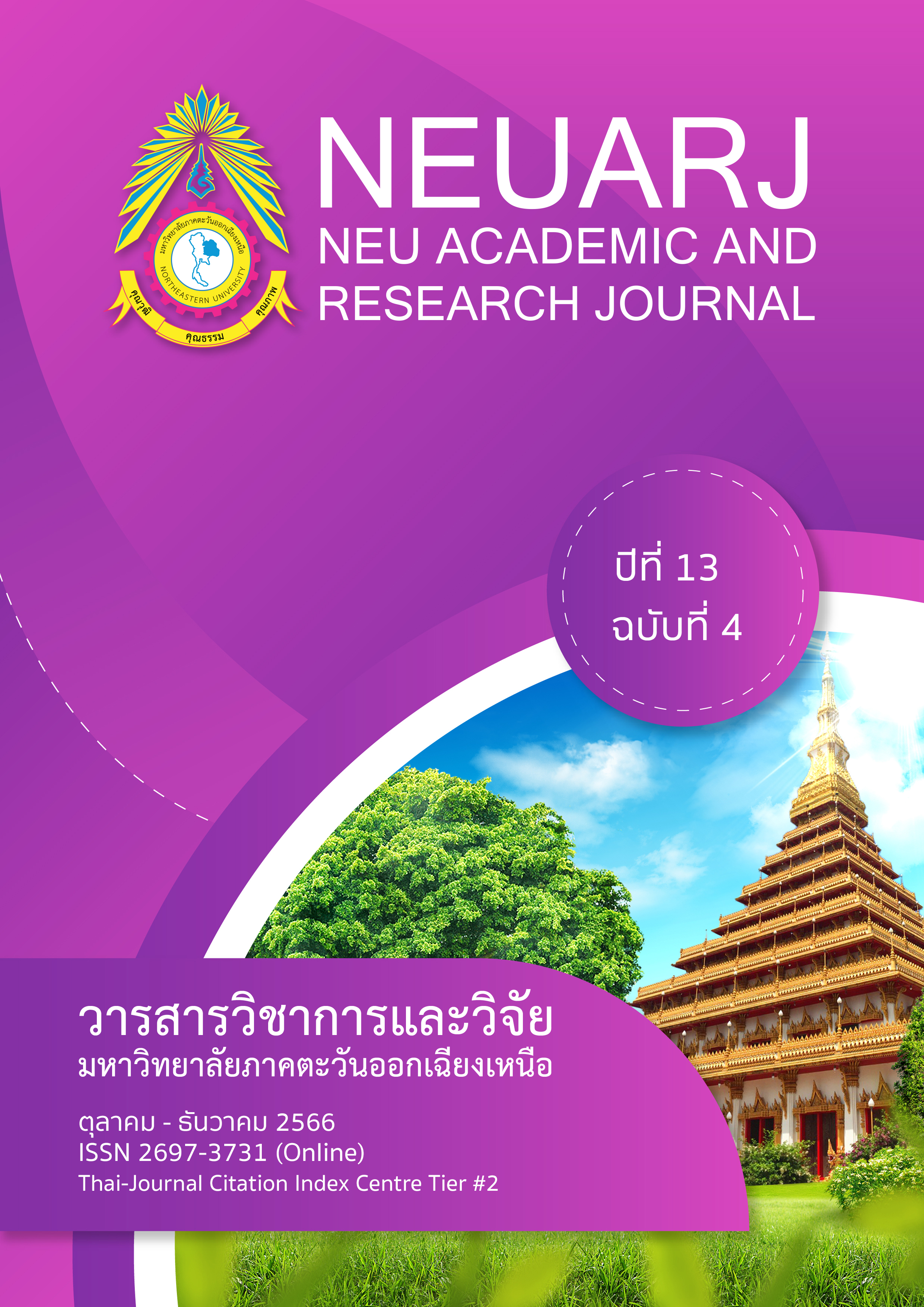STEM literacy Stem Literacy of Graduates Diploma Program in Teaching Profession through Stem Education Learning Activity, Learning and Classroom Management Subject
Keywords:
Stem Literacy, Stem Education Learning ActivityAbstract
This research was the development of STEM literacy of Graduates Diploma Program in Teaching Profession through STEM learning activities. The population were 180 students of the graduate diploma program of Faculty of Education, Northeastern University who were registered to study learning management and classroom management in semester 1, academic year 2022, and the research sample group used in this research consisted of 30 students form cluster random sampling. The research tools included the STEM learning activity plan. Consistency value of the plan was 4.56 and the STEM literacy test was a Likert scale with 30 items, with an IOC value of 1.00 and Cronbach’s alpha coefficient value was 0.98. Statistics used in data analysis were percentage, mean, and standard deviation. The research results found that all students of Graduates Diploma Program in Teaching Profession through STEM learning activities were 100 percent. There was a very high level of STEM literacy with an average between 4.47 – 4.70, with the overall level of STEM literacy being at the highest level ( = 4.61 and S.D. = 0.65)
References
กมลฉัตร กล่อมอิ่ม. (2559). การจัดการเรียนรู้แบบบูรณาการสะเต็มศึกษา สำหรับนักศึกษาวิชาชีพครู วารสาร ศึกษาศาสตร์ มหาวิทยาลัยนเรศวร, 18(4), 334-348.
กรรณิการ์ เกศคำขวา, ลัดดา ศิลาน้อย และ อังคณา ตุงคะสมิต. (2565). การศึกษาทักษะการแก้ปัญหาอย่างสร้างสรรค์และผลสัมฤทธิ์ทางการเรียน โดยใช้การจัดการเรียนรู้แบบ S-STEM(Social Studies-STEM) ในรายวิชา ส 22107 สังคมศึกษา ของนักเรียนชั้นมัธยมศึกษาปีที่ 2 โรงเรียนบ้านสาวิทยาสรรพ์ จังหวัดกาฬสินธุ์. วารสารวิชาการและวิจัย มหาวิทยาลัยภาคตะวันออกเฉียงเหนือ, 12(3), 257-274.
นวพร ชลารักษ์. (2558). บทบาทของครูกับการเรียนการสอนในศตวรรษที่ 21. วารสารวิชาการมหาวิทยาลัยฟาร์อีสเทอร์, 9(1), 64 – 71.
ปัฐมาภรณ์ พิมพ์ทอง. (2561). การจัดการเรียนรู้วิทยาศาสตร์ระดับประถมศึกษาตามแนวทาง STEM Education (พิมพ์ครั้งที่ 1). กรุงเทพฯ: บริษัท วีสต้า อินเตอร์ปริ้นท์ จำกัด.
รุ่งรัตน์ ธรรมทอง. (2565). เอกสารมคอ. 3 รายละเอียดของรายวิชาการจัดการเรียนรู้และการจัดการชั้นเรียน รหัส ED31206. ใน หลักสูตรประกาศนียบัตรบัณฑิตวิชาชีพครู คณะศึกษาศาสตร์มหาวิทยาลัยภาคตะวันออกเฉียงเหนือ.
สถาบันส่งเสริมการสอนวิทยาศาสตร์และเทคโนโลยี. (2557). ความรู้เบื้องต้นสะเต็ม (พิมพ์ครั้งที่ 1).กรุงเทพฯ: สถาบันส่งเสริมการสอนวิทยาศาสตร์และเทคโนโลยีกระทรวงศึกษาธิการ.
สิรินภา กิจเกื้อกูล. (2558). สะเต็มศึกษา STEM Education. วารสารศึกษาศาสตร์ มหาวิทยาลัย นเรศวร,17(2), 201-207.
แสงสุรีย์ ดวงคำน้อย. (2566). SEAT Project and STEM Education: กิจกรรมเชิงรุกสำหรับผู้เรียนที่มีความต้องการพิเศษ. วารสารวิชาการและวิจัย มหาวิทยาลัยภาคตะวันออกเฉียงเหนือ, 13(2),254-268.
Anabousy, A and Daher, W.(2022). PRE-SERVICE TEACHERS’ DESIGN OF STEAM LEARNING UNITS: STEAM CAPABILITIES’ ANALYSIS. Journal of Technology and Science Education, 12(2), 529-546.
Kavak, S. (2023). The Evolution and Global Significance of STEM Education in The 21st Century. The Journal of International Scientific Researches, 8(3), 410-415.
Salimi,G., Mohamma, M., Torkzadeh,J. and Heidar,E. (2023). team-based and Collaborative Learning Studies in Flipped Classrooms: A Scoping Review in Higher Education . Interdisciplinary Journal of Virtual Learning in Medical Sciences, 13(3), 149-164.
Srikoom, W. and Faikhamta,C. (2018). Assessing In-service Teachers’ Self-efficacy and Beliefs about STEM Education. Journal of Education, Mahasarakham University, 12(4),169-186.
Tati,T , Firman,H and Riandi,R. (2017). The Effect of STEM Learning through the Project of Designing Boat Model toward Student STEM Literacy. International Conference on Mathematics and Science Education (ICMScE). pp1-9.

Downloads
Published
How to Cite
Issue
Section
License
Copyright (c) 2023 NEU ACADEMIC AND RESEARCH JOURNAL

This work is licensed under a Creative Commons Attribution-NonCommercial-NoDerivatives 4.0 International License.


